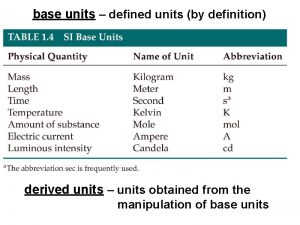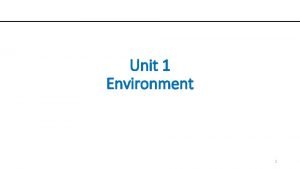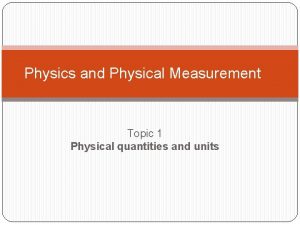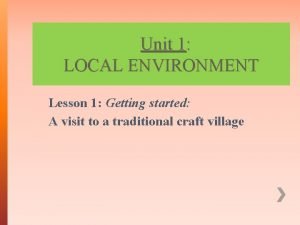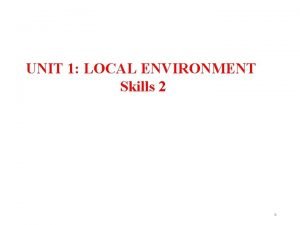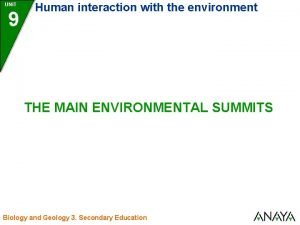Unit 1 Environment 1 Definition of Environment Derived













- Slides: 13

Unit 1 Environment 1

Definition of Environment § Derived from French word Environner § It is multi disciplinary science § The natural environment encompasses all living and non-living things § The environment can be defined as a sum total of all the living and non-living elements and their effects which influence human life. § While all living or biotic elements are animals, plants, forests, fisheries, and birds, etc. § The non-living or abiotic elements include water, land, sunlight, rocks, and air, etc. § But there are two commonly known and accepted types of environment – natural or geographical environment, and man-made environment. 2

Need of Environmental Study § Need for environmental issues § Need for explosively increase in population 1. 16 percent of worlds population 2. 2. 4 percent of land § Need for an alternative solution § Need to save humanity from extinction § To understand the impact of development on environment § To discover sustainable ways of living § To utilize natural resources efficiently § Need for public awareness 3

Segment of Environment § Atmosphere § Hydrosphere § Lithosphere § Biosphere 4

Segment of Environment 5

Layers of Atmosphere 6

Layers of Atmosphere 1. Troposphere § The troposphere is the lowest layer of our atmosphere. § Starting at ground level, it extends upward to about 12 km (6. 2 miles or about 33, 000 feet) above sea level. § We humans live in the troposphere, and nearly all weather occurs in this lowest layer. § Most clouds appear here, mainly because 99% of the water vapor in the atmosphere is found in the troposphere. 2. Stratosphere § The next layer up is called the Stratosphere. § The stratosphere extends from the top of the troposphere to about 50 km (31 miles) above the ground. § The ozone layer is found within the stratosphere. Ozone molecules in this layer absorb high-energy ultraviolet (UV) light from the Sun, converting the UV energy into heat. § This layer contains Sulphates which is necessary for the formation of rain § Commercial passenger jets fly in the lower stratosphere 7

Layers of Atmosphere 3. Mesosphere § Above the stratosphere is the Mesosphere. It extends upward to a height of about 50 km (53 miles) above our planet. § The has the coldest temperatures in Earth's atmosphere, about -90° C (-130° F) 4. Thermosphere § It extends upward to a height of about 800 km § High-energy X-rays and UV radiation from the Sun are absorbed in thermosphere, raising its temperature to hundreds or at times thousands of degrees. § Satellite revolves in this orbit of thermosphere. 5. Exosphere § It extends upward to a height of about 3000 km § some experts consider thermosphere to be the uppermost layer of our atmosphere 8

Hydrosphere § A hydrosphere is the total amount of water on a planet. § The hydrosphere includes water that is on the surface of the planet, underground, and in the air. § A planet's hydrosphere can be liquid, vapor, or ice. On Earth, liquid water exists on the surface in the form of oceans, lakes and rivers. Distribution of Earth's Water Supply Locked in Polar Ice Caps; 2% Fresh Water; 1% Ocean Water; 97% Ocean Water Fresh Water Locked in Polar Ice Caps 9

Hydrosphere Domestic Use; 7% Industrial Water Use; 13% Irrigation; 30% Thermal Power Plant Irrigation Thermal Power Plant; 50% Industrial Water Use Domestic Use 10

Lithosphere Crust 40 Km Upper Mantle Lower Mantle 70 63 Km Outer Core Inner Core 11

Environmental Issues 1. Greenhouse Effect § The greenhouse effect is a natural process that warms the Earth's surface. § When the Sun's energy reaches the Earth's atmosphere, some of it is reflected back to space and the rest is absorbed and re-radiated by greenhouse gases. The absorbed energy warms the atmosphere and the surface of the Earth. § Greenhouse gases (CHG) include water vapor, carbon dioxide, methane, nitrous oxide, and ozone. The major greenhouse gases are water vapor, which causes about 36 -70% of the greenhouse effect on Earth , carbon dioxide, which causes 9 -26%; methane, which causes 4 -9%, and ozone, which causes 3 -7% § Some greenhouse gases are Nitrous oxide and Chlorofluorocarbons. § Since 1970, CO 2 emissions have increased by about 90%, with emissions from fossil fuel combustion and industrial processes contributing about 78% of the total greenhouse gas emissions increase from 1970 to 2011. § Agriculture, deforestation, and other land-use changes have been the second-largest contributors 12

Environmental Issues 2. Climate Change § The heat is melting glaciers and sea ice and shifting precipitation patterns § Much of this melting ice contributes to sea-level rise. Global sea levels are rising 0. 13 inches (3. 2 millimeters) a year, and the rise is occurring at a faster rate in recent years. § Rising temperatures are affecting wildlife and their habitats. § Precipitation (rain and snowfall) has increased across the globe, on average. Yet some regions are experiencing more severe drought, increasing the risk of wildfires, lost crops, and drinking water shortages. § Ecosystems will continue to change: Some species will move, others, such as polar bears, won’t be able to adapt and could become extinct. § Our food supply depends on climate and weather conditions. Although agricultural practices may be adaptable, changes like increased temperatures, water stress, diseases, and weather extremes create challenges for the farmers and ranchers who put food on our tables. 13
 Derived unit definition
Derived unit definition Environment derived from which word
Environment derived from which word Si derived unit of pressure scientist
Si derived unit of pressure scientist Difference between fundamental and derived unit
Difference between fundamental and derived unit Is the unit for density base or derived
Is the unit for density base or derived Unit 10, unit 10 review tests, unit 10 general test
Unit 10, unit 10 review tests, unit 10 general test Lying fundamental position
Lying fundamental position Bend standing derived position
Bend standing derived position Environment of business finance
Environment of business finance Unit 1 business and the business environment
Unit 1 business and the business environment Unit 1 local environment
Unit 1 local environment Defining globalization
Defining globalization Unit 1 local environment skills 2
Unit 1 local environment skills 2 Unit 9 sustainable development
Unit 9 sustainable development
